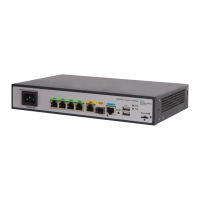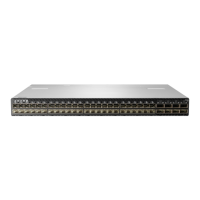41
Views
Path jitter operation view
Predefined user roles
network-admin
Parameters
ip-address&<1-8>: Specifies a space-separated list of up to eight IP addresses. Each IP address
represents a hop on the path.
Usage guidelines
The path jitter operation first uses tracert to detect each hop to the destination. It then sends ICMP
echo requests to measure the delay and jitters from the source to each node. If multiple routes exist
between the source and destination, the operation uses the path specified by using lsr-path
command.
Examples
# Specify 10.1.1.20 and 10.1.2.10 as the hops on the LSR path for the path jitter operation.
<Sysname> system-view
[Sysname] nqa entry admin test
[Sysname-nqa-admin-test] type path-jitter
[Sysname-nqa-admin-test- path-jitter] lsr-path 10.1.1.20 10.1.2.10
max-failure
Use max-failure to set the maximum number of consecutive probe failures in a UDP tracert
operation.
Use undo max-failure to restore the default.
Syntax
max-failure times
undo max-failure
Default
A UDP tracert operation stops and fails when it detects five consecutive probe failures.
Views
UDP tracert operation view
Predefined user roles
network-admin
Parameters
times: Specifies the maximum number in the range of 0 to 255. When this argument is set to 0 or
255, the UDP tracert operation does not stop when consecutive probe failures occur.
Usage guidelines
When a UDP tracert operation detects the maximum number of consecutive probe failures, the
operation fails and stops probing the path.
Examples
# Set the maximum number of consecutive probe failures to 20 in a UDP tracert operation.
<Sysname> system-view
[Sysname] nqa entry admin test

